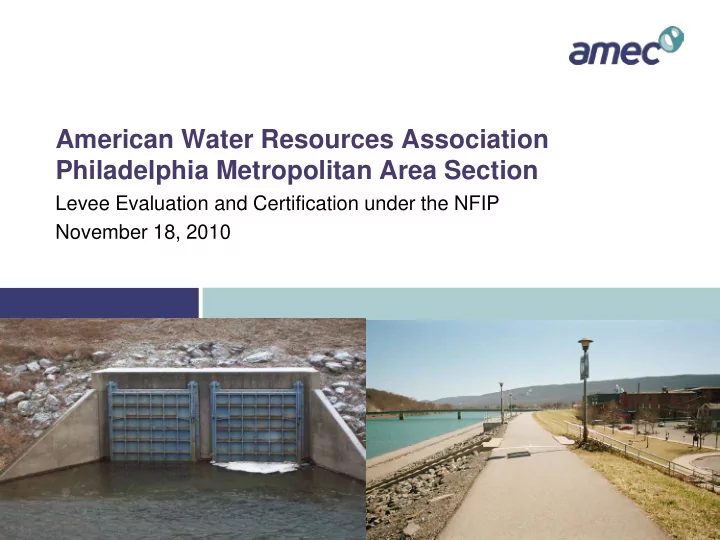

American Water Resources Association Philadelphia Metropolitan Area Section Levee Evaluation and Certification under the NFIP November 18, 2010 Insert picture(s) here
Agenda Background and Overview Flood Insurance Rate Maps (FIRMs) & Levee Accreditation by FEMA Provisionally Accredited Levees (PALs) Consequences of De-Certification Role of FEMA and USACE Technical Requirements for Certification Questions
Background and Overview
Background and Overview
Flood Insurance Rate Maps (FIRMs) & Levee Accreditation by FEMA
Provisionally Accredited Levees (PALs) If CFR 65.10 certification material submitted and approved → PAL designation removed If certification not achieved → levee de -accredited
Consequences of De-Certification Mandatory Flood Insurance Requirements Floodplain Management Requirements Property Values and Tax Base Public Perception RESIDENTIAL (A ZONES) NON-RESIDENTIAL (A ZONES) Building and Contents Building and Contents Coverage (Building/Contents) Annual Premium Coverage (Building/Contents) Annual Premium $35,000/$10,000 $509 $100,000/$50,000 $1,832 $50,000/$15,000 $686 $200,000/$100,000 $3,680 $75,000/$20,000 $887 $300,000/$200,000 $6,012 $100,000/$30,000 $1,143 $400,000/$300,000 $8,133 $125,000/$40,000 $1,399 $500,000/$400,000 $10,240 $150,000/$50,000 $1,653 $600,000/$500,000 $11,237 $250,000/$100,000 $2,766 Source: www.floodsmart.gov Source: www.floodsmart.gov
Does Certification Always Make Sense? Sometimes levee certification may not be fiscally reasonable Cost-benefit analysis appropriate to make determination AMEC typically takes a phased approach to certification evaluations
Role of FEMA and USACE FEMA does not certify levees; it is the responsibility of the levee owner or local sponsor requesting accreditation to provide technical information demonstrating compliance with 44 CFR 65.10 Generally, other than active federal projects, the USACE: – Is not funded, staffed, or mandated to conduct certification evaluations; and – Does not have jurisdiction to perform certifications (per the Thomas Act), except: – On a direct cost reimbursable basis with funding from local sponsors or communities – If local sponsor provides documentation that certification services cannot be procured “reasonably and expeditiously” through ordinary business channels
44 CFR 65.10 Requirements
44 CFR 65.10 Requirements Freeboard – Detailed hydrologic and hydraulic analysis @ 1% annual chance (100-year) standard – Standard Minimum – 3 feet minimum overall; 4 feet within 100’ of structures; + ½ foot at upstream end of levee based on “expected” flow – Absolute Minimum – 2 feet minimum for “expected” flow with uncertainty analysis which considers: – Discharge-frequency uncertainty (i.e. confidence limits); – Stage-discharge uncertainty (i.e. roughness & geometry); and – Sensitivity to downstream assumptions, sediment transport, and debris/ice jams.
44 CFR 65.10 Requirements Closures – All openings must be provided with closure devices that are structural parts of the system during operation and design according to sound engineering practice – Structural and mechanical evaluation
44 CFR 65.10 Requirements Embankment Protection – No appreciable erosion during 1% flood from currents, waves, ice loading, impact of debris, flood duration, and bends – Anticipated erosion will not result in embankment or foundation failure
44 CFR 65.10 Requirements Embankment and Foundation Stability – Demonstrate that seepage into or through embankment will not jeopardize stability – Factors include depth of flooding, embankment geometry, length of seepage path, materials, compaction, penetrations, drainage layers, woody vegetation, etc.
44 CFR 65.10 Requirements
44 CFR 65.10 Requirements Settlement – Demonstrate that minimum freeboard will be maintained with potential future settlement – Analysis must consider embankment loads, compressibility of soil (embankment and foundation), age of levee, and compaction method during construction – Analysis per USACE EM 1100-2-1904 must be submitted
44 CFR 65.10 Requirements Interior Drainage – An analysis must be submitted that identifies the sources of such flooding, the extent of the flooded area, and, if the average depth is greater than one foot, the water-surface elevations of the 100- year flood – Analysis must be based on the joint probability of interior and exterior flooding and the capacity of facilities (such as drainage lines and pumps) for evacuating interior floodwater – Mechanical and electrical evaluation – Failure mode analysis
44 CFR 65.10 Requirements Operations Plans – Closures – Interior drainage systems (i.e. pumps, storage areas, backflow prevention, etc.) – Flood warning systems – Actions and assignments of responsible personnel – Training – Periodic testing and operation (1-year intervals maximum) Maintenance Plans – Maintain stability, height, and overall integrity of levee and associated structures – Replacement of mechanical and electrical parts per manufacturers specifications
Questions Joe Bellini, PE, PH, D.WRE, CFM – Regional Dam & Levee Program Lead – AMEC Earth & Environmental, Inc. – joe.bellini@amec.com
Recommend
More recommend